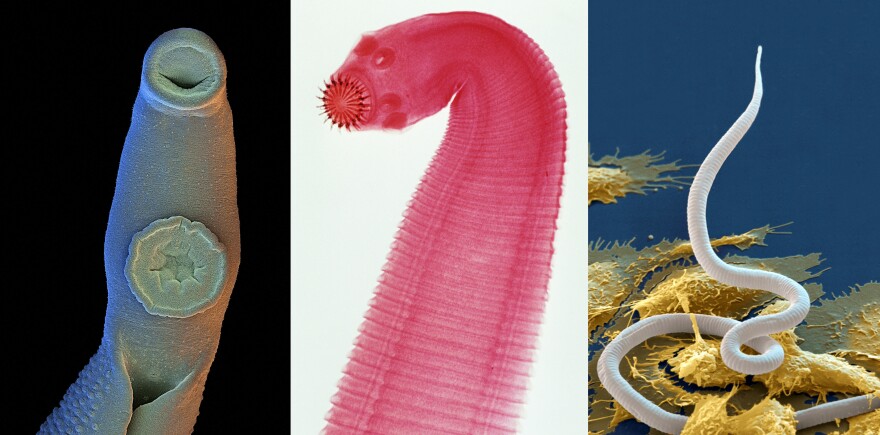As a college undergraduate, I fell in love with parasitic worms. I was studying evolutionary biology, and I got caught up in the idea of organisms that made their world out of other organisms. I was stunned by their ornate life cycles, and the complex biology required to get from host to host, and to live successfully inside those hosts, without being wiped out by the hosts' immune system and without wiping the hosts out and ending the free ride (not to mention the free lunch). The world, I realized, is full of worms.

I wrote my biology senior thesis in college about the life cycle of the schistosomes, the blood flukes that make their home in human blood vessels, where, as adult flatworms, they live permanently coupled (in copula said my textbook, poetically), producing eggs. The worms cause schistosomiasis, also known as "snail fever," whose symptoms can include anemia, abdominal pain and kidney and liver damage. And eventually, the infection can be fatal. The eggs are excreted out with either feces or urine, If they get to water, they hatch into swmming larvae, called miracidia, which seek out snails, their intermediate hosts. Inside the snails, they go through a couple of larval stages, then emerge as cercaria, tadpole-shaped larvae that can penetrate human skin and find their way to the blood vessels and there they mature to that adult stage, where they live in copula and produce the eggs that continue the cycle. As a life cycle it is almost impossibly baroque, with specialized larvae navigating from mammals to molluscs to mammals, and adults pairing off in the blood vessels — and yet the parasites are extremely widespread. An estimated 240 million people worldwide are infected with schistosomiasis.

If the world is full of worms, the parasitic worms who make their homes in humans are a staggeringly diverse group, ranging from those schistosomes, who are trematodes or flukes, flatworms without body cavities to the hookworms, which live in our GI tracts, where they hook on and suck blood. The hookworms are nematodes, or roundworms, a completely different phylum of invertebrates with a very different worm anatomy, and a completely different life cycle — their eggs hatch in warm moist soil, and the larvae burrow up through bare human feet. Other roundworms — such as the microfilaria, which cause elephantiasis and river blindness — are transmitted to humans by biting flies which inject the larval worms into our blood vessels.
And then there are the cestodes, or tapeworms — again, a different biology, a different worm anatomy. These are hermaphroditic segmented flatworms, with each segment a complete reproductive system, so that each segment can become stuffed with eggs. And the tapeworms take a different route into our bodies; tapeworm larvae infect an intermediate host, a pig or a cow, and we get the infection by eating insufficiently cooked meat.
So look at all the ways that worm life-cycles have evolved to take advantage of human habits and human behavior. They can get into the water that we wade in or the ground on which we walk. They can get into the animals we eat and can hitch rides on the insects that like to suck our blood, which is to say, they can get into the animals which like to feed on us. They can complicate the steps that children take to school, or the ways that adults fetch water or grow crops or catch fish for dinner.
I went off to graduate school to study the evolutionary biology of parasitic worms. And as I studied with experts in the fields of medicine and public health, I found myself drawn toward their perspective, becoming interested not only in how these life cycles evolved but also in the question of how they could be interrupted. I was fascinated by the worms, but I began to understand better how much suffering they could cause, and to resent the ways in which they exploited poverty and disadvantage, and made health disparities more extreme. I wrote my medical school application essay about schistosomes, and about using scientific knowledge to interrupt cycles which led to human disease.
I am now a pediatrician, and to tell the truth, though I come across the occasional case of pinworms (another intestinal nematode, common in young children, even in New York City, and relatively benign and easy to treat), worms are not a big part of my practice. But I remain interested in how the patterns of our lives expose us to infections and create vulnerabilities that other species may exploit.
Parasitic worms coevolved with us in premodern times, and nowadays they mostly burden people who are living without some of the benefits and conveniences of modern sanitation and engineering. In other words, the "worm burden" is most likely to hold back people who are already at risk for socioeconomic reasons. Worms become a kind of multiple jeopardy; they don't necessarily kill their hosts (though sometimes they do), but they badly damage health, well-being, strength, economic potential. Hookworms and other gastrointestinal nematodes thrive when poor sewage disposal meets warm climate meets poverty so that children are walking barefoot on infested soil. And the anemia caused by severe hookworm infestations can stunt those children physically and developmentally. Humans and schistosomes coevolved over millennia before HIV became an issue, but schistosomiasis now turns out to be an important contributing factor for AIDS, especially in women, who can develop a condition called female genital schistosomiasis, which makes them much more likely to acquire HIV from an infected partner through sexual intercourse.
In recent years, some of the lesser-known diseases mostly found in the tropics, mostly among the poor, have been designated the Neglected Tropical Diseases. Maybe they have drawn less attention than malaria or HIV, because they are often debilitating rather than immediately deadly, precisely because effective parasites evolve so as not to kill off their hosts too quickly. Or maybe they have been under the radar because they do so much of their dirty work among the people least likely to be visible or vocal on the world stage. And then, of course, you have to consider the ick factor; not everyone likes to contemplate parasitic worms. But 6 of the 7 most common Neglected Tropical Diseases targeted in the End7 Initiative of the Global Network for Neglected Tropical Diseases are caused by parasitic worms (the seventh is bacterial). The campaign, which looks to end these diseases, takes advantage of mass treatment strategies with the effective medications that are now available cheaply through industry partnerships.
The world is full of worms, and parasitic worms offer yet another perspective on the endless diversity and inventiveness of the natural world. It's a somewhat painful perspective, since these are organisms evolved to exploit us, their immunologic subtleties and their anatomical adaptations all weaponized to gain entry into our bodies, evade our defenses, take up longstanding residence so they can sap our energy and sometimes literally suck our blood. They damage bodies and help hold communities in poverty. They stunt potential and end lives.
But in considering parasitic worms and their inventive strategies, and in inventing our own strategies to take them down, we understand better our place in the world around us as we consider our own role as potential worlds for worms.
Perri Klass is professor of journalism and pediatrics at New York University, where she is the director of the Arthur L. Carter Journalism Institute and practices pediatrics at Bellevue Hospital.
Copyright 2021 NPR. To see more, visit https://www.npr.org.



